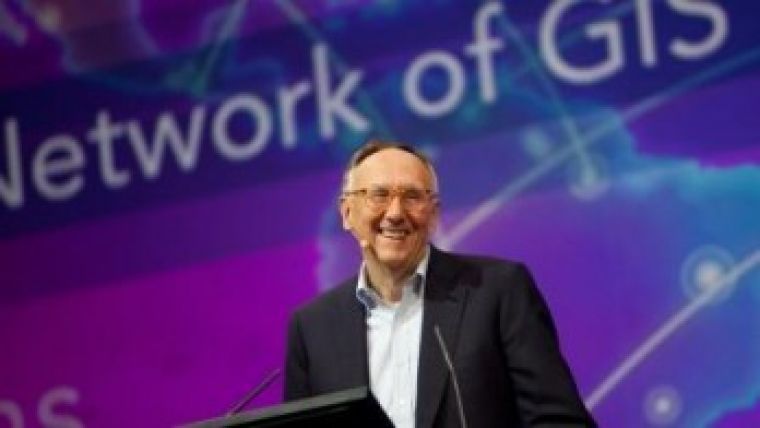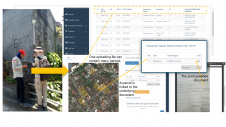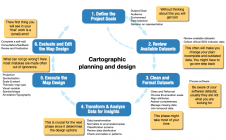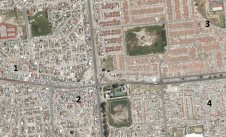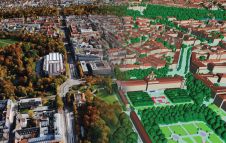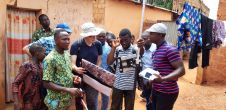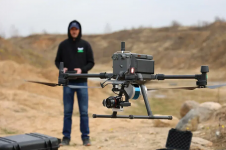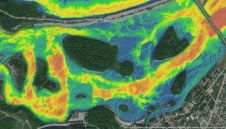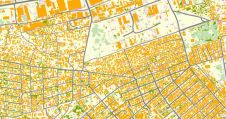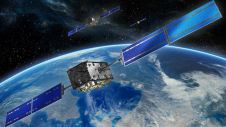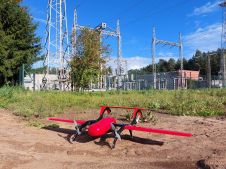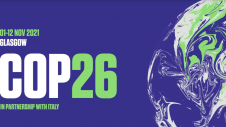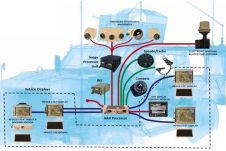Staying Debt-free Gives Us the Freedom to Do the Right Thing
188金宝搏特邀GIM国际采访杰克·丹蒙德(Jack Dangermond)
“保持私人、无债务的人给了我们一个级别的freedom to do the right thing that we would never have in a heavily-leveraged company or public company,” Jack Dangermond states in this interview. He has been exposed to entrepreneurship from a very early age. “Success requires a sustainable revenue model, that is more money coming in than going out. This sounds simple but you would be surprised how few people understand this when starting a business.” He considers himself lucky to have discovered the world of computational geography and to have developed it into a technology that helps people apply geographic services everywhere.
What motivated you and your wife Laura to start Esri in 1969?
在1960年代末我去哈佛大学学习cape Architecture and was exposed to early computer mapping and spatial analysis. I had already been doing geographic analysis manually, but at Harvard they were exploring how to do it with computers. I became interested in the application of the new data technology developed by Carl Steinitz and others at the Harvard Lab, and began using it for several student projects and thinking about how it could be used in environmental planning and spatial decision-making. I moved back to California and started Esri, which focused on the application of that technology to real-world environmental planning projects. That led to the development of software products, and the rest is history.
Your parents, immigrants from The Netherlands, owned a family business. Esri is also a family business. Is that a coincidence?
Entrepreneurship is something I was exposed to from a very early age, so it seemed very natural to start a business that would support my interests. Today that would be called a start-up! Clearly, the business skills I learned from my parents gave me a real-world ‘business school’ education that proved invaluable.
What type of company will Esri evolve into over the next ten years?
GIS continues to grow and evolve, based on advancing technology and user requests. Esri will also continue to grow and evolve in service to our users. Right now, we are adding cloud technology to our offerings of GIS technology. This, together with geoservices and device apps, is making GIS much easier and more pervasive, leveraging the connectivity of the web. It’s embedding GIS almost everywhere, in virtually everything we do. It’s our hope that this will transform how humans see the world and ultimately how they act.
Technology and societal needs are changing rapidly. What are your thoughts on how GIS tools will adapt to those changes?
Esri has a long history of carefully watching what is going on around us and adapting as an organisation. We started out as a consulting firm doing project work, and over time created a product based on what we had learned. Gradually we transformed into a software company. With recent changes in information technology and in our own offerings, we are in the midst of another evolutionary step of leveraging cloud computing and various apps that provide applied geographic knowledge pervasively. One of the things we are particularly focused on is making our technology easier to use and available to more people. This is really the ‘appification’ of GIS. GIS has traditionally been a professional's technology, but now we are seeing knowledge workers who have never touched GIS before accessing it through focused applications that run on mobile devices or in web browsers. Another initiative that’s changing the way we and our customers operate is our increasing focus on sharing data openly. Data used to be a severely limiting factor in many applications of GIS. Now our platform comes with content. Content is not an add-on to the platform; it is integral to the platform and makes the platform come to life. This ready-to-use content is both curated by Esri as well as authored and made available by our users.
Your big data drive may be summarised as the aim to develop computational means for unravelling hidden relationships between geo-related phenomena, not only in space but also in time. How can big data play a role in unveiling such relationships?
Many of our customers are looking at ways to implement big data technology platforms. We are supporting this in a number of ways, including development of new big data tools and partnerships with big data platform companies. What people are discovering is that GIS technology is a natural platform for integrating data from many sources and analysing patterns, trends and relationships, particularly using real-time data. Maps are a way to visualise the story behind your data: seeing spatially enabled big data on a map allows you to answer difficult questions and to ask new ones that you otherwise never would have thought to ask.
Around 50% of Esri’s revenues stem from US federal government agencies. There is a lot of geopolitical turmoil right now. How will the sliding panels affect Esri’s business activities?
来自美国联邦政府机构的ESRI收入的实际金额接近20%。但是,我们约有60%的用户在公共部门,分布在国家,州和地方各级以及大多数国家。政府是地理空间技术的重要用户,这并不奇怪。他们是大多数关于地理决策的监管者,并负责管理大型地区。政府用户也是数据的重要创建者。实际上,已故的“ GIS之父”罗杰·汤姆林森(Roger Tomlinson)博士在1960年代为加拿大政府工作时创建了第一个计算机化的地理信息系统,试图解决全国各地的土地使用和资源问题。尽管地缘政治动荡以及经济不确定性肯定会对政府活动产生影响,但总的来说,这种动荡对GIS业务的影响很小。尽管GIS肯定不是防衰退的,但仍然有浓厚的兴趣将地理信息应用于几乎每个问题。这些问题中有许多正是GIS非常适合解决的问题。
Esri is a California-based company which is little known to the general public, in contrast to Google Maps which is used by billions of people, mostly through their smartphones. Do you have any regrets that you have never evolved into a consumer-facing company?
Google has made a huge contribution by opening the world’s eyes to the power of geospatial visualisation. This has definitely helped us and our users to explain GIS and its benefit to organisations everywhere. The geospatial market is clearly distinguished between the Google-style consumer applications and the professional enterprise market which is supporting geocentric workflows, data management, analytics and decision-making. Through the rapid growth of GIS in the cloud (ArcGIS Online) together with apps on any device, GIS has become much easier and more consumer-facing. This is exposing the full power of our users’ GISs to entirely new audiences.
您对雇用专业人员和奖金补偿的管理理念是什么?
我们专注于雇用真正的好人,他们完成工作。We pay them fairly, and stay focused on serving our users and developing technology that matters to them.We’ve always been opposed to sales-commission compensation, because we want our staff to genuinely focus on helping our users solve their problems rather than trying to sell something in order to get a commission.
What is your philosophy concerning taking outside investments stemming from stockholders or venture capital?
We have avoided outside investments and believe that has contributed to our stability and long-term success. Being independent has let us focus on what is important for our customers. Our users appreciate this. Today, we spend about 29% of our annual revenues on innovation. That’s considerably more than a ‘normal’ public company spends annually on research & development.
您对年轻企业家和初创企业的信息是什么?
首先,我敦促他们找到他们真正喜欢的东西和真正重要的东西。通常这两件事是连接的。我很幸运地发现了计算地理世界,并将其开发为一种技术,该技术可以帮助人们在各地应用地理服务。我们从一开始就做出了选择,不接受外部投资,无债务并保持私密。我并不是说这很容易,但是保持私人和无债务使我们可以自由地做正确的事情,而这是我们在杠杆率高的公司或上市公司中永远不会拥有的。其次,如果您希望成功,则需要为产品或服务提供可持续的收入模型。简而言之,这意味着进出的钱比出去更多。不要说“我们以后会弄清楚收入模型” - 后来可能永远不会来,也可能为时已晚。这听起来很简单,但是您会惊讶于很少有人在开展业务时理解这一点。
Biography of Jack Dangermond
A landscape architect by training, Jack Dangermond founded Esri in 1969 with a vision that a mapping and analysis framework could provide a deeper understanding of our world and help us design a better future. As founder and president of Esri, Dangermond's leadership and vision stimulate the ongoing innovation of GIS technologies that enable people to make insightful decisions and improve the quality of life everywhere. Dangermond has had a strong impact on the development of GIS methodologies, the GIS software market, GIS technology research and related analytical methods. He has received many awards reflecting the influence of his work, including the British Cartographic Society Medal, the John Wesley Powell Award of the U.S. Geological Survey, the Carl Mannerfelt Gold Medal of the International Cartographic Association, the Patron's Medal of the Royal Geographical Society, and the Alexander Graham Bell Medal of the National Geographic Society.
Make your inbox more interesting.Add some geo.
Receive a weekly summary of the biggest news, along with the best stories, case studies, and key market insights.
Sign up for free
